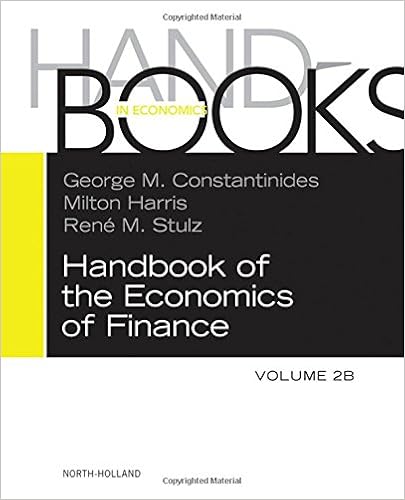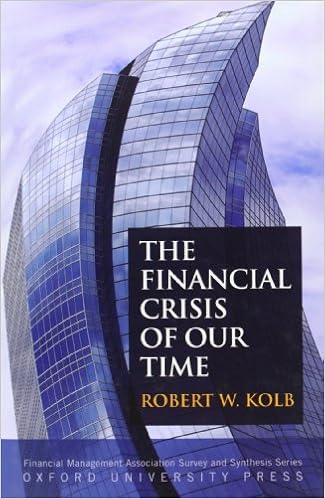The 12 articles during this moment of two parts condense fresh advances on funding automobiles, functionality size and overview, and chance administration right into a coherent springboard for destiny research. Written via international leaders in asset pricing learn, they current scholarship concerning the 2008 monetary problem in contexts that spotlight either continuity and divergence in research. in the event you search authoritative views and critical information, this quantity exhibits how the limits of asset pricing have increased and while have grown sharper and more inclusive.
- Offers analyses by means of best students of contemporary asset pricing scholarship
- Explains how the 2008 monetary crises affected theoretical and empirical research
- Covers center and newly constructing fields
Preview of Handbook of the Economics of Finance, Volume 2B: Asset Pricing (Handbooks in Finance) PDF
Similar Finance books
The Complete Idiot's Guide to Personal Finance in Your 20s & 30's
You're no fool, in fact. You're financially self reliant: You pay hire, utilities, and loans all from your personal paycheck. that your mom and dad needed to minimize the wire ultimately, and you're pleased with how good you've adjusted. but if it involves saving cash for the lengthy haul, you are feeling like an astronaut whose oxygen twine has been reduce.
The choice resolution by way of Bob Rice is the 1st publication to give an explanation for the recent international of different making an investment innovations, exhibiting tips on how to use those new items for inflation-protected source of revenue, risk-adjusted development, and long term wealth move. The Yale Endowment retains in simple terms 6% of its investments in US shares, yet its portfolio has produced a a hundred% achieve during the last decade.
Way of the Turtle: The Secret Methods that Turned Ordinary People into Legendary Traders
“We're going to elevate investors similar to they increase turtles in Singapore. ”
So buying and selling guru Richard Dennis reportedly stated to his long-time good friend William Eckhardt approximately 25 years in the past. What all started as a gamble approximately no matter if nice investors have been born or made turned a mythical buying and selling test that, earlier, hasn't ever been instructed in its entirety.
Way of the Turtle finds, for the 1st time, the explanations for the luck of the secretive buying and selling procedure utilized by the gang referred to as the “Turtles. ” Top-earning Turtle Curtis religion lays naked the complete test, explaining the way it used to be attainable for Dennis and Eckhardt to recruit 23 usual humans from all walks of lifestyles and educate them to be remarkable investors in exactly weeks.
Only nineteen years outdated on the time-the youngest Turtle by means of far-Faith traded the most important account, making greater than $30 million in precisely over 4 years. he's taking you backstage of the Turtle choice method and at the back of closed doorways the place the Turtles realized the profitable buying and selling ideas that enabled them to earn an ordinary go back of over eighty percentage in keeping with 12 months and gains of greater than $100 million. You'll notice
* How the Turtles made money-the rules that guided their buying and selling and the step by step tools they undefined * Why, even supposing they used an analogous process, a few Turtles have been extra winning than others * the right way to glance past the principles because the Turtles applied them to discover center concepts that paintings for any tradable industry * easy methods to follow the Turtle technique to your individual trades-and on your personal existence * how you can diversify your buying and selling and restrict your publicity to chance
Offering his detailed standpoint at the adventure, religion explains why the Turtle manner works in smooth markets, and stocks well-merited knowledge on taking dangers, determining your personal course, and studying out of your mistakes.
The Financial Crisis of Our Time (Financial Management Association Survey and Synthesis)
In 2006 residential actual property costs peaked and commenced to fall, then threatened the world's monetary associations in 2007, and faced the worldwide economic climate with catastrophe in 2008. some time past few years, hundreds of thousands of individuals have misplaced very massive parts in their wealth. And whereas the markets have rebounded significantly, they're nonetheless faraway from an entire restoration.
- Financial Crises, Liquidity, and the International Monetary System
- Creative Cash Flow Reporting: Uncovering Sustainable Financial Performance
- Fooling Some of the People All of the Time, A Long Short Story
- The Little Book of Sideways Markets: How to Make Money in Markets that Go Nowhere (Little Books. Big Profits)
- The Large-Cap Portfolio: Value Investing and the Hidden Opportunity in Big Company Stocks
- Shredded: Inside RBS: The Bank That Broke Britain
Extra resources for Handbook of the Economics of Finance, Volume 2B: Asset Pricing (Handbooks in Finance)
999 and a coefficient of relative possibility aversion of 10. Panel B of Table nine reviews that the model-implied suggest extra go back to a five-year bond is ready one percentage a yr. This proof is encouraging, not less than initially look. notwithstanding, there are 3 issues of this stagflation-based rationalization. One is proven in determine 2. The version implies a negatively-sloped genuine yield curve. As Piazzesi and Schneider be aware, whilst traders worry stagflation, genuine bonds are fascinating resources. the USA empirical proof indicates a certainly sloped genuine yield curve, even if united kingdom proof issues within the different path. Given the quick pattern of genuine yields, we won't fear a lot approximately this challenge. A more vital challenge is that the knowledge don't converse essentially concerning the significance Bond Pricing and the Macroeconomy eight 7 Percent/year 6 five four three 2 1 zero zero 1 2 three four five 6 7 eight nine 10 adulthood (years) determine 2 suggest actual and nominal yield curves implied by means of recursive application. The decrease (upper) line is the unconditional suggest actual (nominal) yield curve implied via a recursive software version and anticipated joint dynamics of intake development and inflation. The time expense of choice is zero. 999 consistent with zone, the coefficient of relative hazard aversion is ten, and the pliancy of intertemporal substitution is one. the information pattern is 1952Q2 via 1985Q4. of stagflation within the information. a fair extra very important challenge is that nominal yields don't behave within the approach that the recursive application version implies they behave. in response to the empirical workout summarized in desk nine, the statistical reliability of the stagflation tale is a bit vulnerable. for instance, the asymptotic t-statistic for the suggest extra go back in line with sector is ready 1. 7. in spite of the fact that, this workout ignores info after 1985. It additionally ignores any details that different observables, comparable to bond yields, can have concerning the dynamics of intake progress and inflation. we should always contemplate diversified info samples and extended issue versions to guage the robustness of those effects. comfortably, we have already got an extra set of parameter estimates in hand. remember the 1st of the issue types anticipated in part four. three. This version makes use of 4 components to catch the joint dynamics of inflation, intake progress, and nominal bond yields. The envisioned size equation is ′ ηc,t Bc �˜ct Ac π˜ t Aπ Bπ′ ηπ,t $(1) = $(1) + $(1) ′ xt + $(1) (50) ηt . B A y˜ t ′ $(20) A$(20) y˜ $(20) B $(20) ηt 945 946 Gregory R. Duffee This size equation overidentifies the recursive application version. In that version, the A$ and B $ coefficients for the nominal yields are capabilities of the model’s different parameters. For this empirical workout we forget about the envisioned values of A$ and B $ for the bonds to target the predicted joint dynamics of inflation and intake progress. (Overidentifying implications are mentioned under. ) I additionally estimate a three-factor version with intake development, inflation, and the three-month yield as observables.





